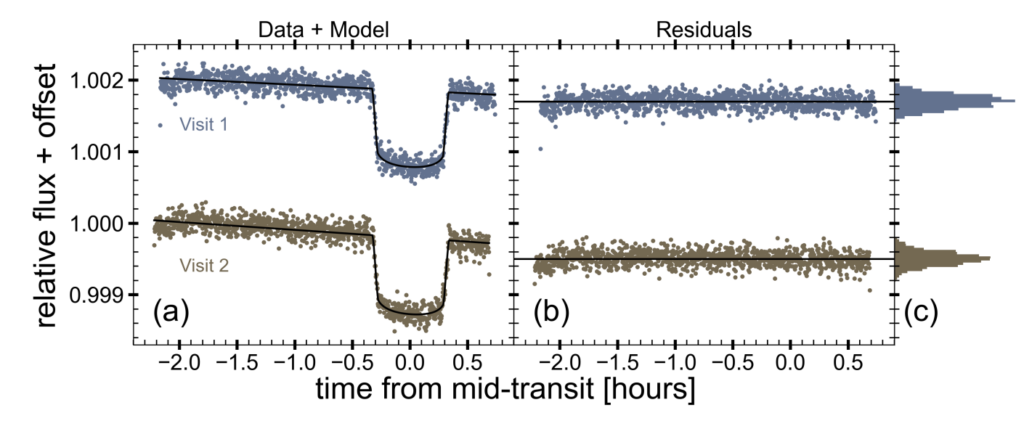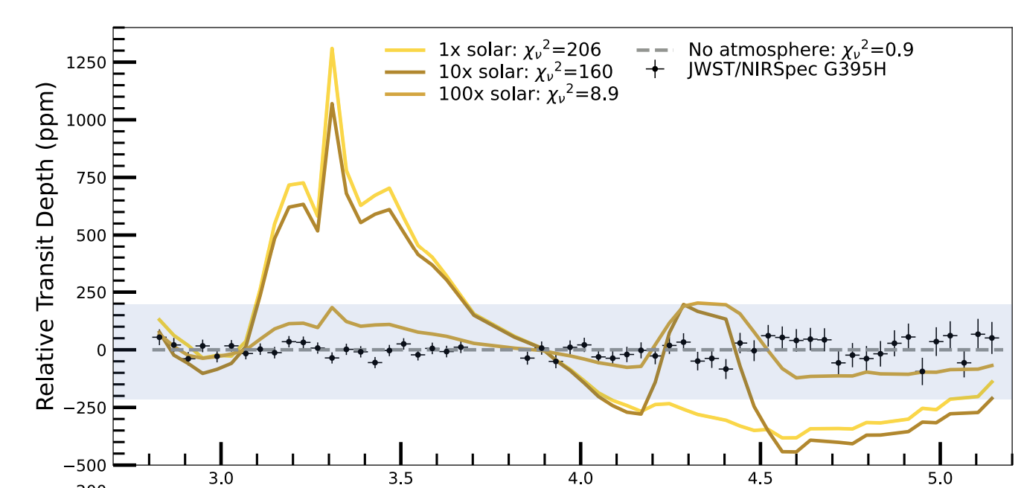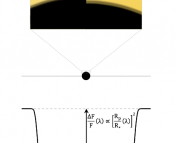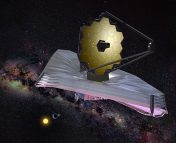Title: A JWST transmission spectrum of a nearby Earth-sized exoplanet
Authors: J. Lustig-Yaeger, G. Fu, E.M. May, et al.
First Author’s Institution: Johns Hopkins University, USA
Status: submitted to Nature, available on arxiv [open access]
A crucial step in determining whether life can exist on exoplanets is characterizing their atmospheres. Today’s paper describes observations of an Earth-like exoplanet taken with the James Webb Space Telescope (JWST), that allowed the authors to constrain the properties of the planet’s atmosphere. This result was also presented this week at a press conference at the ongoing meeting of the American Astronomical Society (check out more coverage of the meeting here!)
How to study exoplanet atmospheres?
Exoplanet atmospheres can be studied using a technique called transmission spectroscopy. When an exoplanet “transits” in front of its host star, it blocks some of the starlight, causing a dip in the observed brightness of the star. But this can vary across the color of light, or wavelength. If the exoplanet has an atmosphere, molecules in that atmosphere can absorb additional starlight at specific wavelengths corresponding to electronic transitions in the molecules. This results in a larger drop in the star’s brightness (aka increased “transit-depths”) at some wavelengths compared to others. Measuring this is akin to taking a spectrum of the atmosphere – you are basically measuring how much light the atmosphere absorbs as a function of wavelength. Multi-wavelength monitoring of the brightness of the star-planet system during the transit can thus help characterize the chemical composition of the exoplanet atmosphere.
These measurements require an extremely sensitive instrument (you not only want to measure the total drop in brightness, you need to resolve the differences between the drops at different wavelengths). Additionally, the molecules of interest such as water, methane have strong absorption features at infrared wavelengths (~1-10 um). Since it is an infrared telescope, JWST with its unprecedented sensitivity is ideal to make these measurements.

LHS 475b – a nearby, earth sized exoplanet
For their study, the authors chose the nearby system LHS 475. This system consists of an M-dwarf star with a candidate rocky planet (named LHS 475b) orbiting around it at a period of ~2 days. The authors observed two transits of this exoplanet with the Near-infrared spectrograph (NIRSPEC) on JWST. The observations cover a wavelength range of 2.8 – 5.3 um (for context, the wavelength of visual light is ~0.3-0.7 um).
The authors first combine all the light across 2.8-5.3 um to construct the “white light” transit lightcurves for LHS 475. These lightcurves are shown in Figure 1. Fitting these observations to theoretical transit models, the authors derive that the planet LHS 475b has a radius R ~ 0.99 Rearth (6319 +/- 318 km). Although the mass of LHS 475b cannot be directly measured using this data, assuming that its composition is similar to other rocky, M-dwarf exoplanets gives a mass of ~ 0.91 MEarth. The similar size and mass of LHS 475b to earth makes studying its atmosphere even more intriguing!

The atmosphere of LHS 475b
Next, the authors analyze the transit lightcurves at different wavelengths to derive the transmission spectrum – transit depth as a function of wavelength (shown in Fig. 2). Surprisingly, the transmission spectrum is featureless, no wavelength shows a larger transit depth than any other! This allows the authors to place strong constraints on the atmospheric composition. For example, they can rule out a pure methane atmosphere, as methane has strong absorption features at 3.3 um that are not seen in the data. The data also strongly rules out hydrogen-dominated atmospheres (similar to Jupiter). A pure water or an Earth composition atmosphere is also weakly ruled out by the data.
So what is the atmosphere of LHS 475b? The data is actually marginally consistent with LHS 475b not having an atmosphere at all! If it does have one, the atmosphere must be very compact and confined to a small height above the planet’s surface, making it hard to detect by JWST. In this case, the atmosphere has to be very weak (like Mars) or very cloudy and hazy (like Venus or Titan). The authors note that future observations with JWST at even longer wavelengths with the MIRI instrument could help distinguish between the no-atmosphere and weak, cloudy atmosphere hypotheses.
The authors thus demonstrate that their observations are sensitive enough to place meaningful constraints on earth-like exoplanet atmospheres. Similar observations of additional exoplanets will be key to finding whether any other planets have earth-like atmospheres!
Edited by Mark Popinchalk
Featured image credit : NASA/JPL-Caltech/T. Pyle (SSC)




